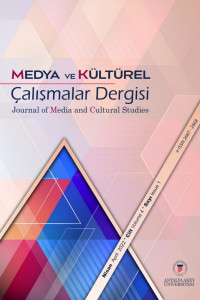Tek Mekanda Gözetim, Sorgulama ve Hüküm: Netflix Dizisi Criminal (2019-)
Bu çalışma, Netflix'in orijinal polis prosedüre dizisi Criminal’i (2019) analiz etmektedir. Araştırma, dizinin alt tür ve anlatı açısından ayırt edici özelliklerine odaklanacaktır. Bu çalışmanın çıkış noktası, Criminal’in akademik ortamda tartışılmaya değer olduğu fikridir. Aynı mekanda geçen bir prosedürel dizisi olan Criminal, dört farklı ülkenin polis sorgulamalarını anlatıyor. Prosedürellerin tarihsel gelişimine ve teorik, edebi arka planlarına bu araştırmada değinilecektir. Bu makalenin vaka çalışması, Criminal dizisini üç tema üzerinden tartışmıştır: Dijital gözetim, tek mekanlı ortam ve anlatı formülü. Çalışma sonunda elde edilen bulgulara göre, Criminal dizisinin polis prosedürel türünün önceki örneklerine farklılık getirdiği görülmektedir. Dört farklı ülkede geçse de sadece sorgulama sahneleri ile tek bir mekanda çekilmiş ve prosedürelin çok mekanlılık geleneği ve algısını değiştirmiştir.
Anahtar Kelimeler:
Polis Prosedürel, Netflix, Gözetim, Tek Mekan, Suç
Surveillance, Interrogation and Verdict in Single Place: Netflix Series Criminal (2019-)
This study analyzes the Netflix original police procedural series Criminal (2019). Research is going to focus on distinctive features in terms of procedural sub-genre characteristics and narrative. The starting point of this work is the idea that Criminal is worth discussed in the academic milieu. Criminal, a police procedural TV series taking place in the same location, tells four different countries’ police interrogations. Historical development and theoretical background of procedurals are going to be covered. The case study of this article discusses Criminal through three themes: Digital surveillance, single space setting, and narrative formula. According to the findings obtained at the end of the study, it is seen that the Criminal series brought a difference to the previous examples of the police procedural genre. Although it takes place in four different countries, it was shot in a single location with only interrogation scenes and changed the multi-place tradition and perception of the police procedural genre.
Keywords:
Police Procedural, Netflix, Surveillance, Single Place, Crime.,
___
- Bailey, F. Y. (2017). Crime Fiction. In Oxford Research Encyclopedia of Criminology and Criminal Justice
- Baldwin, J. E. (2015). Human Nature and Cop Art: A Biocultural History of the Police Procedural.
- Bauman, Z. (2013). Liquid modernity. John Wiley & Sons.
- Bentham, J., & Božovič, M. (1995). The panopticon writings. Verso Trade.
- Breu, C. (2005). Hard-boiled masculinities. U of Minnesota Press.
- Cummins, I., Foley, M., & King, M. (2014). ‘… And After the Break’: Police Officers’ Views of TV Crime Drama. Policing: A Journal of Policy and Practice, 8(2), 205-211.
- Edmondson, M. (1999). Getting a clue: Incorporating hard-boiled detective fiction into the social studies curriculum. OAH Magazine of History, 13(2), 56-58.
- Feasey, R. (2008). Masculinity and popular television. Edinburgh University Press.
- Gemill, A. (2019). ‘Criminal’ Review: An Intriguing Netflix Crime Drama Whose Parts Are Better Than the Sum. Collider.
- Giles, D. (1985). A structural analysis of the police story. American Television Genres, 67-84.
- Gulddal, J. (2016). Clueless: Genre, Realism, and Narrative Form in Ed McBain's Early 87th Precinct Novels. Clues, 34(2), 54.
- Harpham, J. S. (2014). Detective Fiction and the Aesthetic of Crime. Raritan, 34(1), 121.
- Humpherys, A. (2017). British Detective Fiction in the 19th and Early 20th Centuries. In Oxford Research Encyclopedia Of Literature.
- Jenner, M. (2016). American TV detective dramas: serial investigations. Springer.
- Kaminsky, S. M. (1974). American film genres: Approaches to a critical theory of popular film.
- Knight, S. (2010). Crime fiction since 1800: detection, death, diversity. Macmillan International Higher Education.
- Koskela, H. (2003). ‘Cam Era’—the contemporary urban Panopticon. Surveillance & Society, 1(3), 292-313.
- Ogura, T. (2006). Electronic government and surveillance-oriented society. Theorizing surveillance: The panopticon and beyond, 270-295.
- Palmer, T. (2008). Paris, city of shadows: French crime cinema before the New Wave. New Review of Film and Television Studies, 6(2), 213-231.
- Phillips, G. D. (2012). Out of the Shadows: expanding the canon of classic film noir. Scarecrow Press.
- Scaggs, J. (2005). Crime fiction. Routledge.
- Silet, C. L. P. (1994). The 87th Precinct and Beyond: Interview with Ed McBain, Armchair Detective: A Quarterly
- Simpson, P., Rzepka, C. J., & Horsley, L. (2010). A Companion to Crime Fiction.
- Wheat, C. (2010). How to Write Killer Fiction: The Funhouse of Mystery & the Roller Coaster of Suspense. SCB Distributors.
- Winston, R. P., Mellerski, N. C., & James, R. (1992). The Public Eye: Ideology and the Police Procedural. Springer.
- Yayın Aralığı: Yılda 2 Sayı
- Başlangıç: 2019
- Yayıncı: Antalya Akev Üniversitesi
Sayıdaki Diğer Makaleler
Antalya İlinin Coğrafi İşaret Almış Gastronomik Ürünlerinin Değerlendirilmesi
Ali İhsan UYGUN, Yaşar Mert DEMİRAL, Nurcan USLU
Televizyon Ekranlarında Reyting Faktörünün Prime Time Kuşağı Yapımlara Yansıması
Sappho- Rosetti-Willams’ den Lirik Temsiller ve Kompozisyonlar
Tek Mekanda Gözetim, Sorgulama ve Hüküm: Netflix Dizisi Criminal (2019-)
Cüneyt BOZKURT, Emir Orhan KILIÇ
Küresel Salgın Döneminde Marka Saygınlık Yönetimi
Serap BOZKURT, Nüket GÜZ, İrem AYAN
Geleneksel Gelin Algısının Medyadaki Temsili ve Dönüşümü “Gelin Evi” Örneği
Sosyal Medyada Trol Hesaplar ve Algı Yönetimi: COVID-19 Sürecinde Twitter’da Aşı Karşıtlığı
